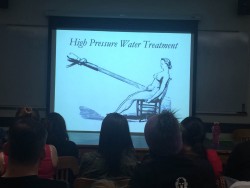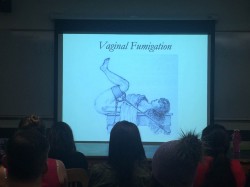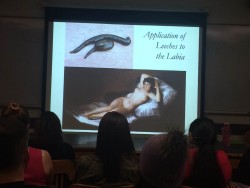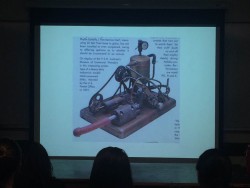Ever wanted to explore the origins of the friend(s) you keep in your desk drawer? Well, you missed the main event, but doge of the dildo Lili Brown has captured the main thrust.
“I wonder how many times I can use the word ‘came’ tonight”
GS Alliance hosted a talk with GS Advising Dean RJ Jenkins on Thursday night that covered a topic unconventional to Dean talks on an unconventional form of a furry little rabbit. Dean Jenkins, given his expertise in Victorian poetry, presented a pictorial history of vibrator technology (and we hear the rabbit vibrators are the best these days), which primarily (and surprisingly) took off during the close-legged time of Victorian Europe.
He began by showing the trailer to a well-casted film called Hysteria, but we didn’t have the sound to accompany it in Schermerhorn 467. The technical difficulties enhanced the intention of showing the trailer; the faces tell it all and I promise it’s funnier Charlie Chaplin style. The “hysterical true story” is both Hollywood and historically true and proves Dean Jenkins’ association with vibrator technology and the Victorian age. But we’ll get to that point in the chronology later.
“If you don’t know what a double dildo is, google it”
First things first, one of ancient civilization’s less-discussed contributions to modern society was sex toys. “People have always liked to have sex,” and shaking up the situation with a stone-age dildo wasn’t uncommon. The ancients used what materials were available to them, for the double dildo pictured is made 100% of jade. Such a high-class toy today would only seem proper for really quality porn or for artistic display in Hugh Hefner’s mansion.
A question asked at the end of presentation clarified the intended use of these early sexual technologies. The placard (covered by a head in the photo) claims that the double-dildo was exclusive to use “by lesbians,” but Dean Jenkins clarified that sexual relations were divided rigidly into two camps during “the dawn of time:” reproductive and pleasurable. Heterosexual activity served the reproductive purpose, and homosexual activity served the pleasurable purpose, which doesn’t just limit lesbians to the use of the double-dildo. As he said, google it.
Hysteria: “You might as well make getting to Jane’s house a little bit of a situation”
The accessibility of vibrator technology and use that we know today stems from its medicalization and industrialization that came with the Victorian age. These bourgeoisie men were obsessed with inventions, which matched with the change in medical discourse during this time. Many upper-class women were diagnosed with hysteria to categorize their “over-sensitivity” and “emotional variability” into a medical term, and this mysterious disease for a mysterious gender accrued a variety of probable remedies.
The first response was to have women sit open-saddle on horses. Remedies centered around the idea that young, unmarried women with hysteria are hysterical due to their dormant vaginas–there isn’t enough blood going to the womb and a blood-rich womb stabilizes female emotions and activity. The womb defined female health (and still does in some way), and male doctors (even today) had no idea how to approach this anatomical enigma. Hysteria thus lives in the womb, and the bumps that rub beneath a woman’s petticoat while horseback could get some blood flowing where it is needed.
But that wasn’t enough. Women were still women, and their aroused horseback state needed to be culminated. The male medical world then realized that a successful amount of blood to the womb would really get women off–literally, an orgasm was now on the medical agenda. In Victorian doctor talk, these women weren’t having enough “hysterical paroxysms,” and doctors were shipped to households for hands-on treatment of hysterical women. “Hysteria” overwhelmingly romanticizes the experience, for very few women would be truly enticed at–or concede to–their husbands calling in a male doctor to manually masturbate them in their living rooms. Dean Jenkins claims this as the origins of the fake orgasm. Regardless, this was a totally standard, preemptive medical procedure.
The “progressive” medical responses that grew out of manual masturbation included the following:
- We hope Summer’s Eve stopped selling these
- Men, stop telling women what constitutes as sexual activity
- Too obsessed with blood-letting
- “You might as well just put this into a medieval torture museum”
And were typically performed on this:
 Though however ridiculous, these inventions and procedures were necessary in sculpting sexual technologies today. Digital stimulation caused another shift in the innovation of sexual technologies in that it mobilized the treatment. Dean Jenkins notes that this mobilization coincides with a time “when women start to get these things called rights,” and the way these medicalized devices are advertised and sold changes parallel to the times.
Though however ridiculous, these inventions and procedures were necessary in sculpting sexual technologies today. Digital stimulation caused another shift in the innovation of sexual technologies in that it mobilized the treatment. Dean Jenkins notes that this mobilization coincides with a time “when women start to get these things called rights,” and the way these medicalized devices are advertised and sold changes parallel to the times.
Victorian influence is found everywhere as the industry grew, for the devices began to more closely imitate male anatomy and women used them per advice of their male doctors. While still perpetuating heteronormative activity, the technology quickly became more popular, and what it’s used for became more “underground.” The advertisement to the right disguises using a vibrator for sexual pleasure as the “jittery needs,” cuing husbands to buy this for their wives at a drugstore. And these cylindrical vibrating devices were sold on the same caliber as other home appliances; Sears catalogues featured them below an ad for the latest Singer sewing machine. With a 21st century more sexually aware mind, Jenkins proclaimed the open marketing for such a socially stigmatized activity as, “it’s like if I had anal beads and tried to convince people I was a marble enthusiast.” Though This vibrator is more what we’re used to, the real change happened at the turn of the mid-nineteenth century.
“The dicks we think we have while we’re on drugs”
The 1970s and 80s with their trailblazing sexual and female liberation movements brought the vibrator industry to what we know it as today. These movements criticized the heteronormativity of the technology–no more male doctors telling females how to get on, no particular replicated genitals going into another specified human genital. The new industry creates devices that “become actual replacements for male anatomy,” and women (especially queer women) begin to enter the industry themselves.
Today, these devices are being incorporated into partnered activities and are designed to go beyond just self-pleasure activities. Dean Jenkins spoke a bit about the We Vibe vibrator, which both vibrates and blasts a mutually-chosen playlist to jam out to.
Now that the rabbit has clearly infiltrated the sex lives of milennials, go think about Alice in Wonderland. “If the rabbit isn’t a metaphor for an orgasm, I don’t know what it is.”


 0 Comments
0 Comments








